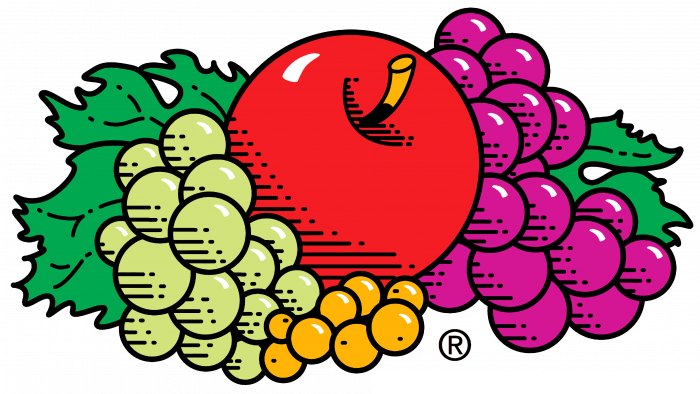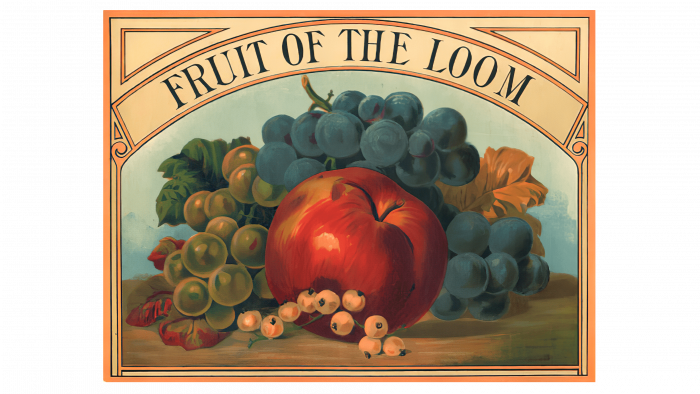The company sews its clothes as masterly as trees and shrubs grow juicy and sweet fruit. The emblem indicates the perfection of styles and a variety of colors. The Fruit of the Loom logo guarantees the buyer will enjoy wearing the items.
Fruit of the Loom: Brand Overview
Meaning and History
The company’s professional career began when the Knight brothers bought Pontiac Mill from Warwick and opened a company called B.B. and R. Knight Corporation. In 1856, they renamed it Fruit of the Loom and launched their first product, muslin.
The goods were sold through the Rufus Skeel store in Providence (a friend of Robert Knight). Skeel had a daughter who drew labels for rolled fabric. Since she liked fruits and berries, she portrayed them. As a result, the demand for the products increased. Fabrics with the Apple logo were especially in demand.
The Knight brothers decided these emblems would be the perfect symbol for the brand. They linked the concept of fruit to biblical motives and their brand name. Therefore, this expression refers to clothing and the phrase “fruit of the womb,” which means children. The exact saying is reflected in Psalm 127: 3 of the Bible.
1971 (after Congress passed the first trademark legislation), the company’s owner immediately patented the logo, receiving the number 418. The Fruit of the Loom brand is registered under this logo. Throughout history, he has had seven emblems.
What is Fruit of the Loom?
It is a manufacturer of casual wear for men, women, and children. Its headquarters are located in the United States, and its factories are located in Morocco.
1893 – 1927
The first logo has a rectangular frame with several lines of different colors and widths. Judging by the quality and style of the image, this is a miniature painting. There is a wide band under the frame, which is shaped like an arc. The name of the trademark is written on it. The still life contains a set of fruits and berries that are as close to real life as possible. In the center is a large red apple with a light highlight on the side.
On the left, you can see many white grapes (usually greenish); above and on the right – a bunch of black grapes (usually dark blue or dark purple). In front of the apple are white currant berries. The image also contains leaves of three colors: green (grape), yellow (apple), and red (currant).
1927 – 1936
The designers have tweaked the brand’s visual identity mark and made it look like an emblem. To do this, they redrawn the picture in a different style (less realistic), removed the tape and placed the fruits in an oval frame. They moved the currant berries to the left, and some leaves changed color. At the same time, the clouds disappeared from the logo – only a light blue background remained. The inscription at the top has been preserved but shaped like an arch. The words “Fruit” and “Loom” are in large letters, and “of the” are in small letters.
1936 – 1951
During this period, the company’s management approved the logo in a lithographic print, which resembles a wax seal in texture, color, and shape. The picture shows fruits and berries taken from a triple-edged circle. At the top, in a semicircle, there is a wide ribbon with the brand name.
1951 – 1962
In 1951, the developers returned the logo to its original color and added a gradient in some places. The grapes turned green and dark blue again, the currants white, and the apple red with a yellow highlight on the side. The designers made the letters black to make the name stand out clearly. They also painted the seal sandy beige.
1962 – 1978
Since this period, the emblem has radically changed its appearance. The authors used an oval in which the company name was placed. So, they emphasized the priorities, highlighting the brand as the main one. The designers moved the picture with fruits and berries (brand concept) to the top, to the center of the line that forms an oval. In doing so, they reduced the brightness of its color gamut. The first letters in the words “Fruit” and “Loom” have become uppercase, the rest – lowercase, but underlined with a black line. In addition, the inscription is supplemented with the phrase “Unconditionally Guaranteed.”
1978 – 2003
In 1978, the fruits and leaves returned to their normal color. Now, they are catchy and distinct. The developers narrowed the oval, stretched it out, outlined it along the edge with a black line, and made it volumetric due to the shadow at the bottom. They removed the underlining in the title, replacing the lowercase letters with uppercase ones.
2003 – today
The modern version of the logo consists of two parts: the first is the text, and the second is the icon. The designers removed the rest of the elements. Fruits and berries are now less vibrant than the previous emblem but still colored. The only difference between them is in the colors. The artists tried to preserve their natural shades, so they made the bunches white and purple, the currants yellow, the apple red with a yellow stalk, and the leaves green (by the way, now they are all replaced by grapes).
The designers also worked with the style of the name: in the current version, it is written in grotesque, thin, elongated letters, except for the middle part. It is in small print and arranged in two lines.
Fruit of the Loom: Interesting Facts
Fruit of the Loom, a famous clothing brand known for making underwear, casual clothes, and sports gear, has existed since 1851. Thanks to the Knight brothers, Benjamin and Robert, it started in Providence, Rhode Island.
- Foundation: The Knight brothers started the company over 170 years ago, initially focusing on cotton fabric.
- Trademark: In 1871, the company got its trademark, making it one of the first in the U.S. Its logo with various fruits is known globally.
- Advertising: The brand is remembered for its “Fruit Guys” ad campaign from the ’80s and ’90s, where people dressed up as fruits.
- Products: Besides underwear, they make T-shirts, fleece, socks, and sports clothes for everyone.
- Worldwide Reach: Fruit of the Loom sells its products worldwide and has factories in the U.S. and other countries.
- Ownership: Warren Buffett’s Berkshire Hathaway bought the company in 2002 after it went bankrupt in 1999, helping stabilize it.
- Cultural Footprint: The brand has appeared in movies, music, and TV and is known for its quality and comfort.
- Innovation: They’ve introduced tagless shirts and underwear to avoid the annoyance of tags.
- Giving Back: The company also gives to education, disaster relief, and local community projects.
Overall, Fruit of the Loom’s big impact comes from sticking to quality, clever marketing, and keeping up with customers’ wants, earning it a special place in homes worldwide.
Font and Colors
The logo’s image of fruits is far from realism—it is made in a hand-drawn design. Horizontal strokes highlight the commonality of the textile industry. Small stripes are visible on the apple’s grapes and left side. They resemble a fabric formed from many intertwined fine threads.
Previously, all the letters in the emblem were serifs, but as a result of the last update, the layout changed: a geometric chopped typeface was chosen for the logo. It is called the Futura Serie BQ-Book and was developed by the German designer Paul Renner, who took the 1919-1933 Bauhaus style as a basis.
Signature colors during the emblem’s modification ranged from bright to restrained. Most natural shades are present: red, pink, yellow, sand, purple, blue, green, white, and blue.
FAQ
What is the meaning of Fruit of the Loom?
The word “fruit” in the name refers to the company’s products. “Fruit” symbolizes garments such as T-shirts, underwear, and socks made on a loom. The choice of this name indicates the naturalness and essential role of the brand’s products. Just as fruit is a fundamental and healthy part of the diet, the brand’s clothing is essential for daily life. They emphasize that their products are as desirable and valuable as fresh fruit.
Who owns the Fruit of the Loom brand?
Berkshire Hathaway, Inc. owns and operates the brand as a separate company. Although it operates independently and has its own management team, it benefits from strong support and oversight from Berkshire Hathaway, a well-known company by Warren Buffett. This structure allows the brand to utilize the parent company’s vast resources and financial stability while managing day-to-day operations and making important decisions independently.
What is the original Fruit of the Loom logo?
The original logo was a colorful still life enclosed in a framed rectangle. The title “FRUIT OF THE LOOM” was displayed at the top of the frame. The design featured a variety of fruits, including apples, grapes, and currants. This vibrant and colorful image reflected the brand name and conveyed the natural quality and freshness the brand wanted to associate with its products.
How long has Fruit of the Loom been around?
It is one of the oldest clothing brands, spanning nearly two centuries. The brand is known for producing a variety of clothing, from underwear to casual wear. The company’s reputation for quality and reliability has stood the test of time. Approaching its 200th anniversary, the brand continues to thrive by adapting to changes in the fashion industry while staying true to its heritage.
Is Fruit of the Loom branded?
Yes, it is a registered brand. This registration confirms that the brand is officially recognized and protected by trademark laws. This protection helps prevent unauthorized use of the name and logo. Being a registered brand is essential to maintaining its identity and reputation in the competitive apparel market. This ensures that all products, from lingerie to casual wear, meet the same quality standards, helping customers recognize and trust what they buy.
Is Fruit of the Loom a good brand?
Fruit of the Loom is widely known as a reliable brand, especially for screen printing options. Their products are designed to provide high-quality printing, making them an excellent choice for custom hoodies and other screen-printed clothing. The brand produces clothing suitable for various purposes, including workwear, school uniforms, and casual wear for men, women, and children.













